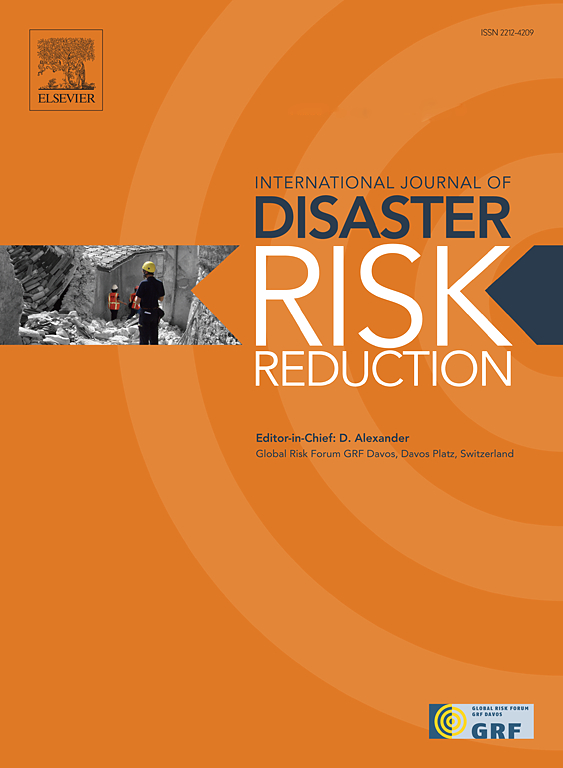生命线网络的灾难恢复分析框架:集成可靠性、冗余性和可恢复性
IF 4.2
1区 地球科学
Q1 GEOSCIENCES, MULTIDISCIPLINARY
International journal of disaster risk reduction
Pub Date : 2025-03-29
DOI:10.1016/j.ijdrr.2025.105436
引用次数: 0
摘要
弹性分析旨在量化系统的风险,并评估其从受损状态恢复并将功能恢复到原始状态的能力。本研究提出了一个评估生命线网络抗灾能力的框架,强调抗灾能力和灾后恢复能力。为了定量评估弹性性能,该框架引入了三个关键标准的指标:可靠性、冗余性和可恢复性。可靠性指标反映了网络组件的结构性能,冗余指标反映了系统级功能容量,可恢复性指标评估了中断后恢复网络功能的能力。采用弹性三角概念定义冗余度和可恢复性指标。对各种初始破坏情景的这些指数进行估算,可以确定影响系统复原力的最脆弱情况,从而有助于制定有效的防灾减灾战略。此外,通过冗余度和可恢复性指数来表示恢复过程的特定场景性能曲线,可以在灾害发生后支持快速和明智的决策。提出的框架通过电力和交通网络的案例研究进行了论证。这项研究有助于提高关键基础设施系统在面对各种灾害时的安全性和功能性。本文章由计算机程序翻译,如有差异,请以英文原文为准。
Disaster resilience analysis framework for lifeline networks: Integrating reliability, redundancy, and recoverability
Resilience analysis aims to quantify the risk of a system and evaluate its ability to recover from a damaged state and restore functionality to its original condition. This study presents a framework for assessing the disaster resilience of lifeline networks, emphasizing both hazard resistance and post-hazard recovery capabilities. To quantitatively assess resilience performance, the framework introduces indices for three key criteria: reliability, redundancy, and recoverability. The reliability index reflects the structural performance of network components, the redundancy index captures the system-level functional capacity, and the recoverability index evaluates the ability to restore network functionality following disruption. The resilience triangle concept is used to define the redundancy and recoverability indices. Estimating these indices for various initial disruption scenarios enables the identification of the most vulnerable situations that influence the resilience of the system, thus aiding in the development of effective pre-hazard mitigation strategies. Additionally, scenario-specific performance curves, representing the recovery process through the redundancy and recoverability indices, support rapid and informed decision-making in the aftermath of a hazard. The proposed framework is demonstrated through case studies of electricity and transportation networks. This research contributes to improving the safety and functionality of critical infrastructure systems in the face of diverse disasters.
求助全文
通过发布文献求助,成功后即可免费获取论文全文。
去求助
来源期刊

International journal of disaster risk reduction
GEOSCIENCES, MULTIDISCIPLINARYMETEOROLOGY-METEOROLOGY & ATMOSPHERIC SCIENCES
CiteScore
8.70
自引率
18.00%
发文量
688
审稿时长
79 days
期刊介绍:
The International Journal of Disaster Risk Reduction (IJDRR) is the journal for researchers, policymakers and practitioners across diverse disciplines: earth sciences and their implications; environmental sciences; engineering; urban studies; geography; and the social sciences. IJDRR publishes fundamental and applied research, critical reviews, policy papers and case studies with a particular focus on multi-disciplinary research that aims to reduce the impact of natural, technological, social and intentional disasters. IJDRR stimulates exchange of ideas and knowledge transfer on disaster research, mitigation, adaptation, prevention and risk reduction at all geographical scales: local, national and international.
Key topics:-
-multifaceted disaster and cascading disasters
-the development of disaster risk reduction strategies and techniques
-discussion and development of effective warning and educational systems for risk management at all levels
-disasters associated with climate change
-vulnerability analysis and vulnerability trends
-emerging risks
-resilience against disasters.
The journal particularly encourages papers that approach risk from a multi-disciplinary perspective.
 求助内容:
求助内容: 应助结果提醒方式:
应助结果提醒方式:


